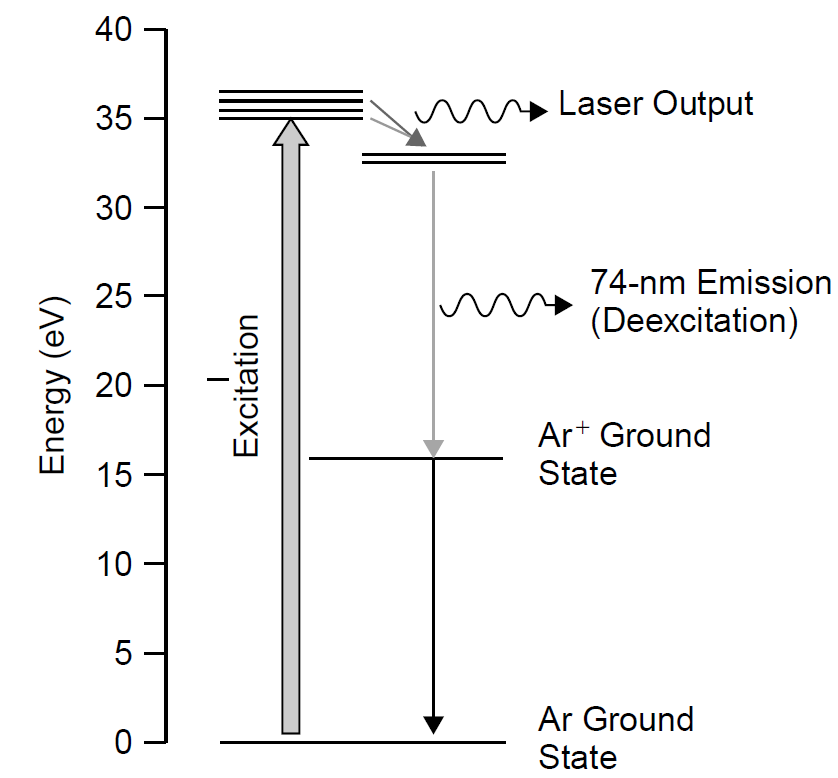
DEPOPULATION OF LOWER ENERGY LEVELS IN FOUR-LEVEL LASERS
 المؤلف:
Mark Csele
المؤلف:
Mark Csele
 المصدر:
FUNDAMENTALS OF LIGHT SOURCES AND LASERS
المصدر:
FUNDAMENTALS OF LIGHT SOURCES AND LASERS
 الجزء والصفحة:
p128
الجزء والصفحة:
p128
 14-3-2016
14-3-2016
 3064
3064
DEPOPULATION OF LOWER ENERGY LEVELS IN FOUR-LEVEL LASERS
In a previous example we saw how the lower lasing levels of the nitrogen laser are depopulated as molecules drop in energy to a metastable state with a lower energy. In any four-level laser, some method of depopulation of the lower lasing level exists. These methods may result in the production of a photon of light (although not one that contributes to lasing action) or as the result of a non-radiative process of the type. The argon laser provides us with a straightforward example of depopulation via radiative energy loss, in which argon ions at the lower lasing levels (around 33 eV above the ion ground-state energy) drop to a lower level by emission of a photon as shown in Figure 1.1. This drop is quite large and results in the release of a photon with 18 eV of energy, corresponding to an extreme-UV wavelength of 74 nm. This photon does not contribute to laser action, nor is it normally observed as a spontaneous emission from the tube since few materials (including quartz windows) are transparent to this extremely short wavelength.
Atoms of neon in a helium–neon laser undergo a two-stage process, outlined in Figure 1.2, to relax to the ground state, from where they can again be pumped to the upper lasing level to take part in coherent light emission. From the lower lasing level neon atoms first undergo a radiative transition to an intermediate level by emission of a photon around 600 nm. This emission contributes to the pink-orange glow (spontaneous emission) seen from an operating He Ne tube. From that intermediate level, radiative emission is not possible, due to quantum mechanical selection rules for allowed transitions, so the only avenue available is collisional transfer of energy between the excited neon atoms and the walls of the laser tube. This also explains a peculiarity with He Ne lasers in that a larger-diameter plasma tube results in the reduction of laser power. In many lasers, such as the carbon dioxide laser, use of a larger-diameter plasma tube results in more gain volume and hence in higher energies being available for a given length of tube, but this is not the case with He Ne lasers. Most He Ne tubes have an inner plasma tube bore of only 1 mm. Use of a larger-diameter tube results in a buildup or bottleneck of neon atoms residing at the intermediate (metastable) energy level. A metastable state has a long lifetime relative to the lifetimes of other levels in the system. In some cases it is an energy level from which a radiative transition cannot occur (due to the selection rules of quantum mechanics), so photon emission as a simple way to

Figure 1.1. Depopulation of the argon-ion lower lasing level.

Figure 1.2. Depopulation of neon atoms in the He Ne laser.
return to ground state is not possible. Many atomic systems, including neon and nitrogen, have such states. In the case of the He Ne laser, neon atoms in the metastable state are no longer available to contribute to laser action, so the gain is reduced and consequently, the output power is also reduced. Small tube diameters are required to allow excited neon atoms to lose energy quickly to the tube walls and again enter the laser process.
The final example of a unique depopulation process is in the semiconductor laser (a four-level laser), in which a non-radiative process occurs. In this laser the ground and lower lasing levels exist within the valence band, and the pump and upper lasing levels exist within the conduction band, as shown in Figure 1.3. Excitation promotes an electron in the semiconductor crystal to a pump level. From that level it falls to the lowest level in the conduction band, which serves as the upper lasing level. Emission occurs between that level and the highest level in the valence band, which serves as the lowest lasing level. This level must depopulate to maintain a population inversion, and does so by falling to a lower level in the valence band. This drop in energy is accompanied by the production of a phonon, a vibration in the crystal lattice of the semiconductor.

Figure 1.3. Depopulation of semiconductor atoms.
 الاكثر قراءة في مواضيع عامة في الليزر
الاكثر قراءة في مواضيع عامة في الليزر
 اخر الاخبار
اخر الاخبار
اخبار العتبة العباسية المقدسة


